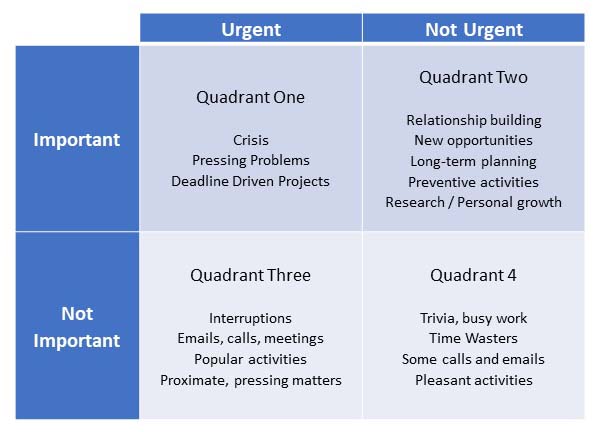Business today is filled with so much pressure to focus on things that are both important and urgent, things that need to be addressed right now! This hair-on-fire pressure forces us into reactive behavior based on what needs to be done right now instead of focusing our energy and resources on developing a more strategic behavior based on our long-term goals. We sometimes feel like we just move from one emergency to the next, never finding enough time to catch our breath and plan for the future.
In the book, The 7 Habits of Highly Effective People, author Dr. Stephen R. Covey popularized the Eisenhower Time Management Matrix.
Under pressure, we often find ourselves in Quadrant One dealing with things that are both urgent and important. Initially, this seems to make sense since the activity is important. But the fact that things are urgent exposes our lack of planning and poor time management. Nobody can do their best work when they are pressed for time.

When you don’t have good time management skills, you can easily find yourself spending time in Quadrant Three, at the will of other people and their needs. Activities in Quadrant Four are a total waste of business time but easily attract our attention if we don’t guard our time well.
We need to spend our time in Quadrant Two, focusing on activities that are important and not urgent because this is where and when we can make the biggest gains in our personal and professional development.
The private one-on-one meeting is the one chance we have each week to reset from the hectic and focus on the strategic.
Here are Four Keys to Effective One-on-Ones.
Key #1 – Establish a Consistent Format
Decide in advance what the standard one-on-one format should be and then stick with it. Publish the format. This way everyone knows what to expect and how to prepare.
One of the biggest selling points of the Radio Advertising Bureau’s Account Manager CRM System is the built-in Weekly One-On-One feature. It has a consistent format for reviewing the key metrics of sales performance like a pacing report, a pipeline report, CNAs and Presentations Made among others. Since the report is based on the salesperson’s call reports and sales activities, it is a great place to focus on the important and the not urgent.
Key #2 – Equal Time for the Seller
The fundamental goal of the effective one-on-one meeting is to communicate. Communication is a two-way activity where both parties exchange ideas and information. The first key to effective one-on-ones is to establish a level playing field where the salesperson’s communication needs are respected.
Devote the first half of the meeting to the seller’s agenda and the second half of the meeting for the manager’s agenda. Salespeople and sales managers should both maintain a reminder file folder where they keep notes about things that are important to them to discuss in the private one-on-one.
Sales managers, open the meeting by asking the sales person to begin with their list of topics. Be patient, hear them out. Give them the help they need.
Salespeople, make sure you use this time to your advantage. You have the sales manager’s attention. Use it wisely to your advantage. Don’t waste this important opportunity. Come prepared.
Key #3 – Stick to the Schedule
Don’t let the private one-on-one meeting run past the scheduled ending time. If you can’t cover everything in the time allotted, you need to schedule a special meeting at a later scheduled time where you can complete your discussions. Letting the meeting run long is poor planning and it’s not fair to the next salesperson in line for their meeting time.
Key #4 – Take Notes, Create a History
The private one-on-one meeting is a wonderful way to track and document progress toward personal and professional goals. Everyone in the organization wants to know where they stand, where does the group stand? Tracking the key metrics from week to week keeps the focus on what’s important for everyone involved. If progress is made, you can look back and celebrate the growth. If not, the private one-on-one meeting is the perfect private environment to discuss plans to get on track.
Conclusion
The private one-on-one meeting needs to be more than the dreaded weekly beat down. It is the best opportunity to make meaningful progress toward personal and business goals. Develop a healthy respect for the process and you’ll start to see dramatic improvement in performance.
Let me know if I can help.
If you enjoyed this article, please take time to share it with your friends and colleagues with the social sharing buttons below.

